| 1 | A neurotoxic black-yellow snake |
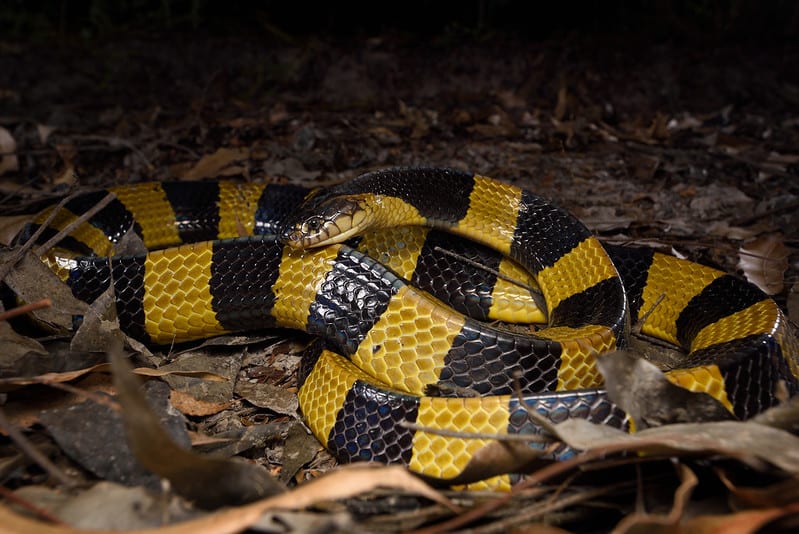
The Bugarus kraits are a genus of venomous snake with at least 18 members, which are spread far and wide across southeast Asia. Rather than athletic chargers, this is a group of night crawlers, which often invade houses or construction workers’ huts while the occupants sleep. All Bungarus members are potentially lethal, but one of the most feared is the banded krait, AKA Bungarus fasciatus.
This species ranges from northeast India, through most of Thailand, Myanmar, to a final stop of Indonesia. They reach a confirmed record of 212.5cm, with an average of 120-150cm. Most kraits are a mixture of black and white, but this species is easy to recognise due to its vivid yellow stripes instead.
Like other kraits, Bungarus fasciatus has a heavily neurotoxic venom. Confirmed ingredients include the post-synaptic neurotoxin α-elapitoxin-Bf1b, and the pre-synaptic neurotoxins P-elapitoxin-Bf1a and beta-bungarotoxin. Banded kraits are more than capable of ending your life, should one sneak through your patio door at night while you sit in the lounge peacefully watching TV.
Banded kraits are able to achieve the following: disable connections between the lungs and brain, paralyse limbs, cause drooping eyelids, and unleash a tsunami of nausea. One confirmed death happened in Myanmar. The victim experienced very few local symptoms, such as swelling or necrosis. Yet neurotoxic symptoms arrived within 2 hours, and the victim died of respiratory failure at 14 hours post bite.
| 2 | An easy snake to ID |
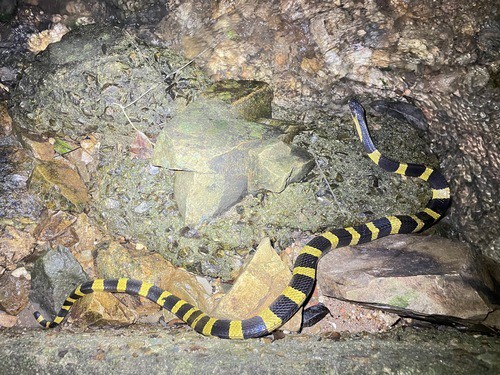
The Bungarus krait genus has 18-20 members worldwide, of which Thailand is home to 3. At 225.5cm, the banded krait easily exceeds its rivals in maximum length. In Thailand, the red-headed krait peaks at 195.5cm, while the Malaysian blue krait (the deadliest of the 3) peaks at 175cm.
These three species are easy to distinguish from each other. Blue kraits are black and white, while red-headed kraits are very dark blue with a red head. Meanwhile, banded kraits are black and yellow, with orderly stripes. But banded kraits are by far the easiest to distinguish from all other snake species. The other two have many non-venomous or mildly venomous copycats. Red-headed kraits have pink-headed reed snakes, while blue kraits are mimicked by banded wolf snakes.
No snakes in Thailand have the dense yellow and black spacing of Bungarus fasciatus. The closest is the Laotian wolf snake (Lycodon laoensis). This is also a pure yellow and black, and probably evolved to convince forest creatures it was loaded with neurotoxic venom, when its deadliest weapons are actually sharp teeth and playing dead. However, Lycodon laoensis has far wavier bands (see here). Instead of disciplined and orderly, they look like they’re reflected in a funhouse mirror. Also, the black sections are more much longer than the yellow, unlike in banded kraits.
| 3 | Heavily nocturnal |
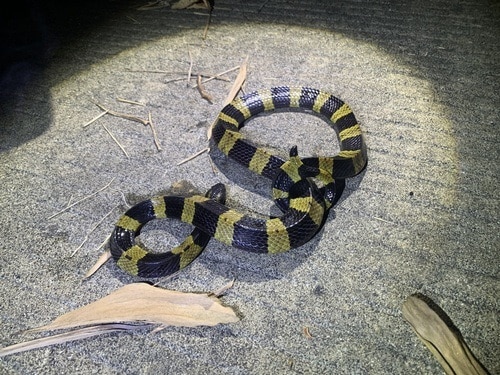
Banded kraits rarely climb trees, and swim only occasionally, mainly to drag watersnakes out of muddy holes in the shores. This is a ground snake through and through.
Banded kraits are heavily nocturnal, and during the day, they’ll rest in dark sheltered hideaways, particularly vacant burrows and termite mounds. Poking your arm into a dark Thai burrow is a foolish idea, one that could end in your untimely demise, but not because of the creature that forged that burrow – because of sneaky kraits taking them over.
Like other kraits, Bungarus fasciatus flips a switch when night falls. Under moonlight, all their aggressive instincts are awakened, and Bungarus fasciatus bites at will, particularly if touched in any way. While they don’t rear up and make stabbing lunges like a cobra, they’ll turn aggressive if they deem their personal space to be invaded. By day, however, banded kraits are timid and sluggish. They rarely strike, and will only sink their fangs and squeeze the attached venom apparatus if they feel severely threatened.
| 4 | Bites: uncommon, but lethal |
Bungarus fasciatus causes far fewer bites than the monocled cobra, white-lipped pitviper, and their relative the Malaysian blue krait. A 9 year Thai study illustrated this well. The survey scanned patients from Ramathibodi Poison Center in Bangkok, to establish symptoms and survival following krait bites. The cases involved the following species: Malaysian blue krait (68), banded krait (7), and red-headed krait (1).
Bungarus fasciatus beat the notoriously secretive red-headed version, but fell way short of the blue krait. The study also revealed the symptoms. Luckily, 3/9 victims received a dry bite, a miraculous fang gnashing where no venom is injected, and that’s an unusually high percentage across the snake kingdom. Of the 6 who were envenomated, none died, but 5 suffered respiratory failure to such a degree that they required intubation and mechanical ventilation.
The average number of antivenom vials administered was 9 per patient, with a range of 3-20. The mean hospital stay lasted for 2 days, with a range of 1-20. The worst affected patient remained on artificial intubation for 15 days. The onset of the earliest neurological symptoms took 30 minutes to 7 hours.
| 5 | Common near ponds and rice fields |
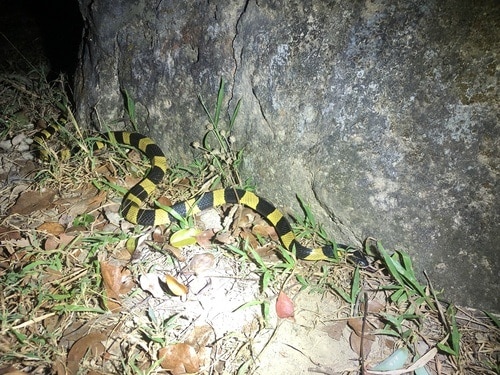
Bungarus fasciatus activates almost the moment darkness falls. They appear in various habitats, but they require one substance – water.
This isn’t a semi-aquatic snake like the rice paddy snake, one that swims in swamps all day and eats amphibians and fish. But banded kraits are nearly always found close to a water body. Their favourite spots include by water channels on the edges of rice fields, in the moist grass next to ponds, and on the borders of wet forests. Shallow streams beds are another possibility. Unlike the Russell’s viper, it’s rare to find them in the centre of agricultural fields like rice paddies, as they much prefer the borders.
Their love of water means that wet season is their most active period. Formerly dry fields and village roads may be inundated with water sloshing around, which opens up a whole new tantalising landscape for banded kraits to feel comfortable in. Sometimes this rainfall goes too far, and flooding forces them to seek dry land inside village houses.
| 6 | Warns people first |
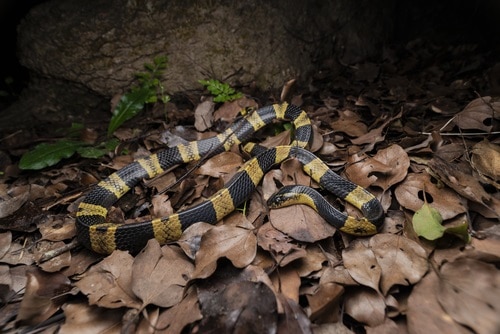
During daylight hours, Bungarus fasciatus even sets up base in drains. This species appears to be sluggish at first glance, moving slowly around the edge of a pond. But this is more efficiency than being a tired snake. Banded kraits save their energy and unleash it all at once when they need to break free from a grip, or lurch their upper body towards the hand gripping the tail, while biting all at once.
Banded kraits have also been witnessed to judder and vibrate their body during daylight when people stray too close. This is theorised to be a warning of some kind, perhaps one that their natural predators are more attuned to than human beings.
If picked up, they sometimes thrash wildly before resorting to biting, to generously give people a brief final warning. Despite the danger, you’ll occasionally find overconfident snake handlers showing banded kraits off in Bangkok bars.
| 7 | Swallows any snake it sees |
Banded kraits have long been known as a fellow snake eater, and the list of confirmed snake species is long. A 1994 report combined all previous diet records of Bungarus fasciatus with results from banded kraits dissected by the author. The result was that 80% contained snake prey in their stomachs. Other meals included 2 eggs, one lizard and one fish, with zero mammals.
Unlike a cobra, Bungarus fasciatus relies more heavily on its sense of smell to hunt than its eyesight. One story involved a fully blind banded krait owned by a Mr. Y. Siah in Bangkok. Despite lacking all visual information, this krait was still able to locate and swallow snake meals placed within its terrarium.
Sometimes, Bungarus fasciatus tastes its own medicine. The other main ophiophagous (snake-eating) snake in southeast Asia is the king cobra, and banded kraits are one of their confirmed prey. Banded kraits are also a necro snake. In Assam state, India, one was spotted eating a decomposing snake, already dead, which was gruesomely confirmed by the presence of maggots.
| 8 | Confirmed snake prey |
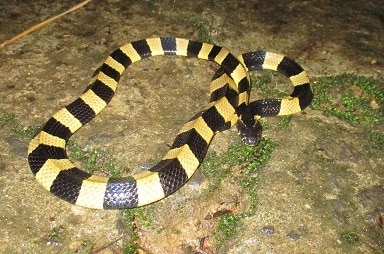
The banded krait’s confirmed meals include…
Sunbeam snake – this iridescent, rainbow-tinged snake appears in almost identical habitats to banded kraits: waterways near rice fields and the grassy edges of ponds. They also become more common after rainfall, so it’s not surprising that banded kraits are confirmed to eat them. A harmless species.
Buff-striped keelback – a similar story. This is a harmless common snake, which constantly appears by ponds and shallow waterways, without actually being an aquatic snake. Banded kraits grab any species which happens to be nearby.
Tonkin pitviper – banded kraits can swallow fellow venomous snakes, as witnessed in Vietnam in 2017. By a small stream, a banded krait swallowed a Tonkin pitviper (Ovophis tonkinensis) which it had already ruthlessly dispatched. The prey’s body was covered in such grisly bite wounds that eggs within its body were exposed.
Wall’s krait/lesser black krait – both fellow members of the Bungarus family, and with a lethal neurotoxic venom, which banded kraits are clearly resistant to.
| 9 | More ID signs |
The banded krait is an egg-laying species, producing 4-14 per batch. These eggs measure 2.6-3.0cm and typically hatch after 59 to 62 days. Hatchlings measure 32-34.9.cm.
Banded kraits appear at altitudes of up to 2300 metres. They also inhabit Nepal, in the foothills of the Himalaya, where it’s known as Rajasaap, or “king of snakes”.
Very occasionally, you can find black-white morphs of the banded krait. This makes them very difficult to distinguish from the Malaysian blue krait. But there’s still consistent ID signs, including a much stumpier tail for the banded krait, versus long and tapered. Banded kraits have a slightly bulkier head, making it more distinct from the body. While both have a triangular body shape when viewed in a cross section, this is even more pronounced in the banded krait. The yellow is normally so bright that it’s rare that you’ll have to use these hidden ID tricks.
As this image shows, the Asian wilds occasionally churn out a striped morph rather than banded. The colours are identical, featuring the usual vivid black and yellow.
| 10 | Living on borrowed time |
As of 2024, banded kraits aren’t just the longest species, but have the most massive range of any Bungarus krait. They occupy a swathe of northeast India, then spread all the way to the Indonesian island of Java, covering thousands of miles. Their yellow-black appearance barely varies. But there’s a problem – according to a 2023 study, there may be 3 hidden species within this vast empire.
Using DNA testing, scientists found large gulfs in genetics, pointing to three long-separated clades: 1) Indonesia and mainland Malaysia, 2) India to Myanmar, and 3) Thailand, Cambodia, Vietnam, southern China, and peninsular Malaysia.
Within the clades, there were small genetic distances. Clade 1 had 0.4% genetic variation, based on different locations in Java. Clade 2 varied by 0.0-1.3%. But between clades, the differences were far larger, including 5.0% between clade 2 and 1, and 5.3% between clade 2 and 3.
These species aren’t officially confirmed yet, but new names have already been proposed: Bungarus insularis for Indonesia and Bungarus bifasciatus for Chinese realms. In fact, there may be up to 6 species within the banded krait. If split, the old Bungarus fasciatus name will apply to the Indian lineage.

Hehehehe..someone that has been envenomated and like 90% of other envenomtated lived to tell the tale. My eysesight has been empacted forever but I have no ED issues so a blessing in disguise I suppose.